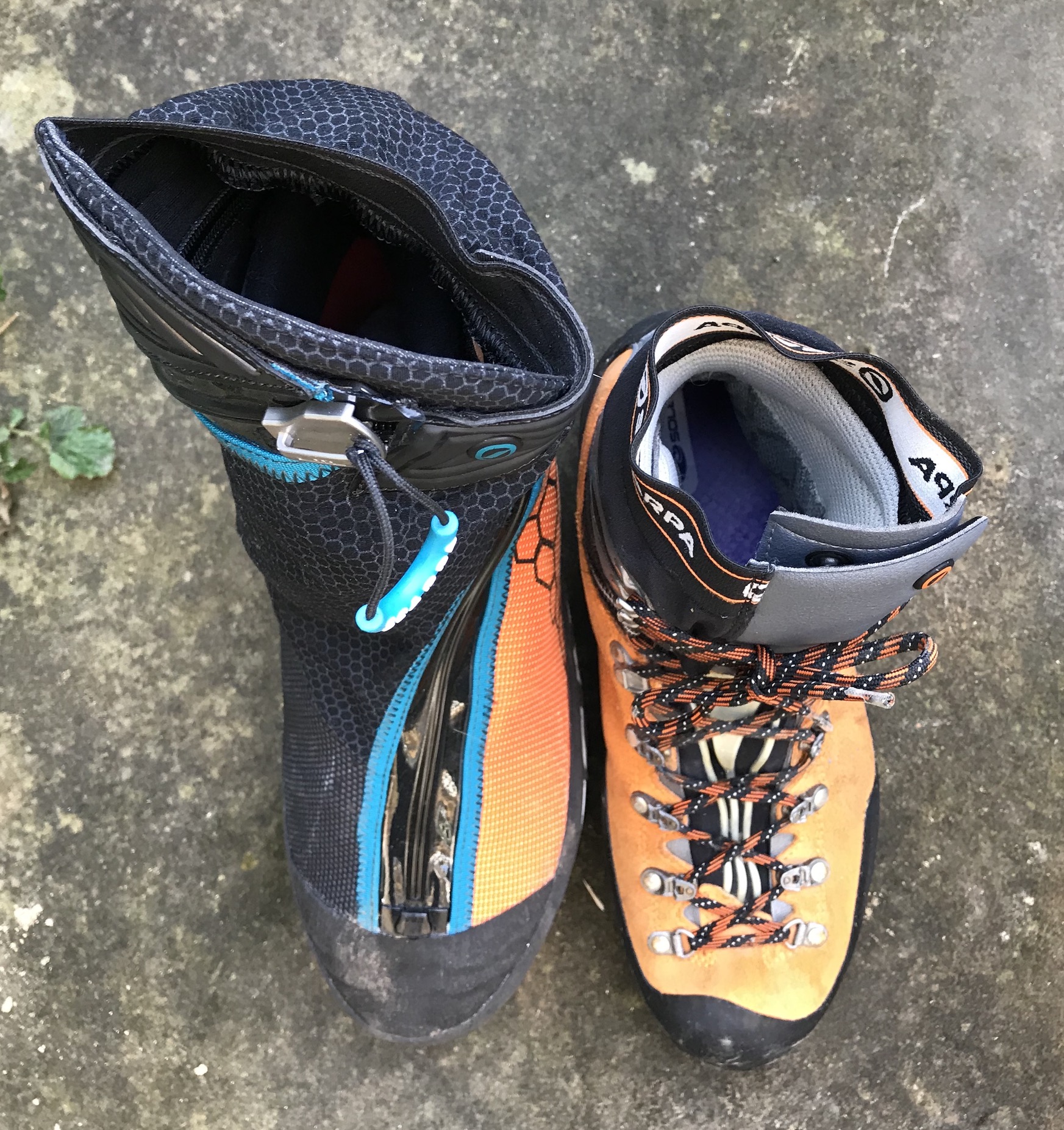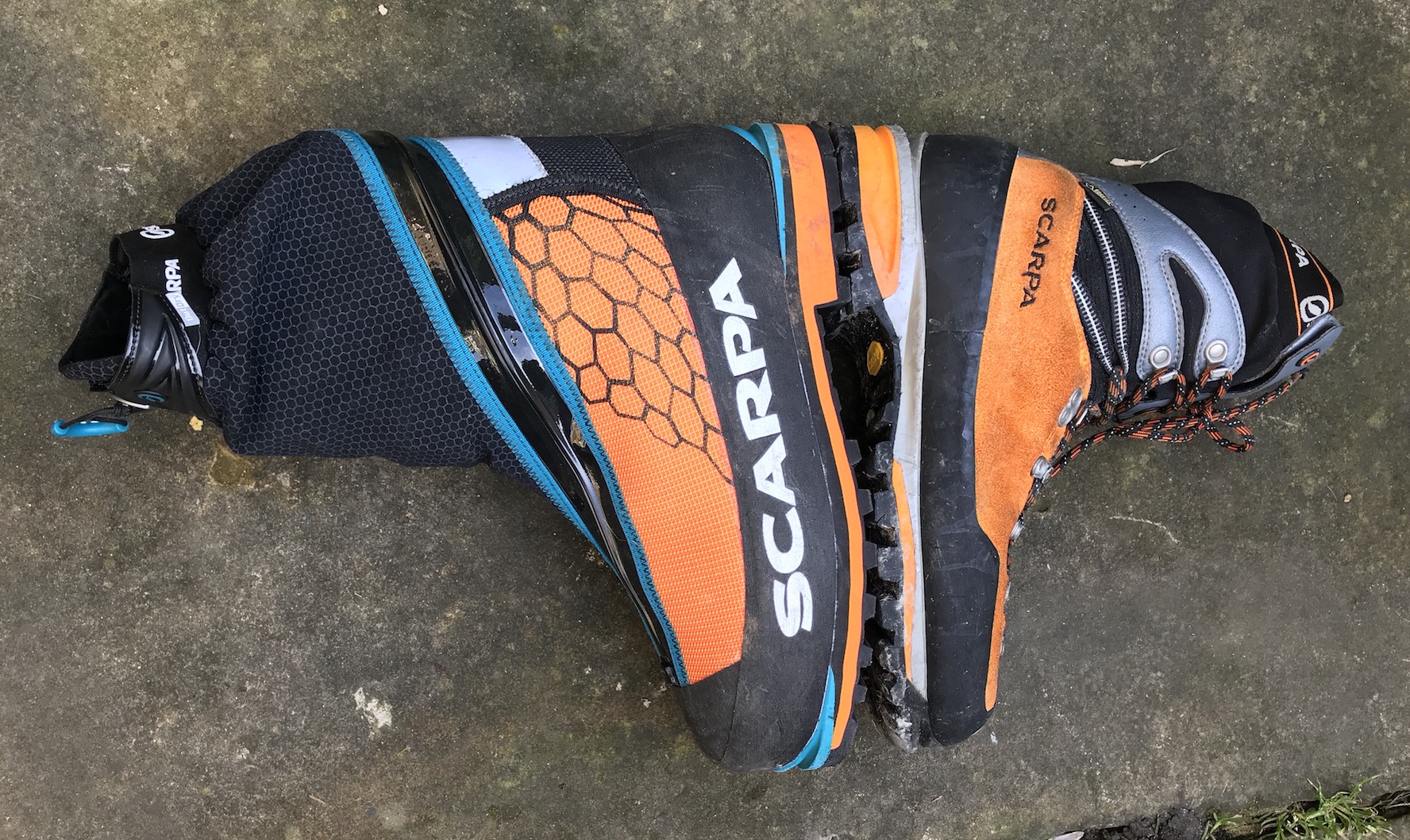


If you’ve been keeping your eye on the ISPO announcements then you’ll know that Scarpa are revamping their Phantom line with the Tech and 8000 being the first to get the treatment. It looks like the Phantom 6000 is unchanged for now and we’ve been putting them through their paces in Scotland prior to some (hopefully) bigger objectives.
Back in 2015 we reviewed the then new Mt Blanc Pro (also revamped this year) and concluded that it was perhaps the best general purpose Scottish and summer alpine boot around – especially for those of us with wide feet. The only chink in the Mt Blanc Pro’s armour was that in truly frigid conditions your toes could get a bit chilly. As someone who suffers from cold feet I’ve had occasions when my feet have gotten cold – usually at belays, especially when buried under spindrift or when the mercury has dropped to below -10 and I’m not moving much. Modern gaitered boots like Phantom line are generally much warmer than standard boots. They keep snow out more effectively and create an extra layer of trapped air on top of whatever insulation is already part of the boot. As you move up to the likes of the Phantom 6000 you get a true double boot bringing with it extra warmth and the ability to ‘dry’ the inners out overnight inside your sleeping bag on a bivi or in the hut. The disadvantages are extra bulk and weight as well as the possibility of a less precise ‘feel’ on technical mixed ground. I was curious to see how they compared when climbing on familiar ground in Scotland and also a little apprehensive as I didn’t want to trash the reputedly fast wearing soles with too much trekking over powder covered rubble.
Weight wise a single size 44 Phantom 6000 comes in at 1114g – about 80g more than a Mt Blanc Pro (size 43.5) and though the upper is obviously bulkier the sole unit is pretty much the same width and only marginally longer – no need to adjust crampons. As a result crampon fit was good with my standard Petzl Darts as well as BD Snaggletooths, I didn’t have any technical Grivel crampons to try but I see no reason for there to be any issues. The photos should give an idea of the difference in depth on the sole unit (it also has a lower density orange centre which is not shown) when compared to my well worn Mt Blanc Pros
The current Phantom 6000 is Scarpa’s MKII iteration, a development from the original orange and white vertical T Zip boot. As with the rest of the Phantom line it gained the spiral ‘helta skelta’ zip (now a lighter YKK) aimed at removing zip stress at the flex point and ‘bulging’ of the boot upper when flexed. The outer boot was also lightened and refined using new materials KCN-Tech nylon, the hardwearing ‘Super Fabric’ with an OutDry lamination and a lighter Vibram sole unit which offers better insulation but less durability. Overall however the boots are no lighter than their predecessors as the insulation has been improved. The inner boot is insulated with Primaloft and EVA, fastening at the side with a generous velcro flap and incorporates two pull on tabs. It seems pretty durable and Scarpa even suggest the slightly grippy sole is suitable for quick trips out into the snow… Some aftermarket liner such as those from Palau will allegedly fit too but we haven’t verified this. One slight disappointment is the innersole is very basic offering little support easily replaced but I wonder how a stiffer more supportive innersole might affect the inner-boot abrasion wise at the edges. The outer boot opens wide with a hinged tongue and two substantial pull on loops to aid sliding the inner boot in place. Fastening consist of a velcro strap ‘power band’ around the cuff and a ‘quick-lace’ system that is easy to operate with gloves and actually seems to stay locked – much better in fact than the system they used on the Ribelle Mountain Tech OD I reviewed. The slight faff of unzipping the spiral zip not withstanding I found the lace system to work really well meaning I was always happy to tighten the laces if needed before starting technical climbing – something that can be a chore depending on your boots.

In Use
Straight out of the box I wore the Phantom 6000 for the trek over to Shelter Stone which turned out to be disappointingly black. After an abortive couple of pitches up Western Union we made the most of the day by a bit of a hike checking out possible future hits. So with the best part of 18kms done on their first outing I had zero blisters or discomfort barring a slight rubbing on my fat calves where my old sock came up a bit short of the gaiter top. The following couple of days I got used to the feel of the boots on technical ground and to be honest after a couple of pitches I forgot about their increased bulk (it’s pretty minimal anyway) and had no problems on short section of tech 7 ground. In fact the increased rigidity compared to my old Mt Blanc Pros was an asset with monos on small edges and dimples. A later trip to Church Door Buttress again found them more than up to the rough walk in soft powder overlying rubble followed by the brilliant daftness that is Crypt Route. The sole on the Phantom 6000 felt like it had a less pronounced ‘rocker’ which makes walking a bit less natural compared to the Mt Blanc Pros but it’s certainly not an issue and may be mostly down to increased stiffness. The biggest concern with the sole is that it is relatively thin – these are boots designed for altitudes where it will be pretty much snow all the time and you’re likely to be climbing any rock with crampons on. They can of course be resoled but they would not be the first choice for a workhorse boot in Scotland or a summer alpine environment. However if you’re not going to be tramping over rock and rubble for long distances, think of uplift in the alps or just being on snow there is less concern. The uppers seem as tough as any other built in gaiter boot and I can see no evidence of early wear that would concern me despite mixed climbing abuse. With over 50km of ‘walking’ wear in them now on typically rough Scottish terrain there is some sole wear but nothing too alarming. Obviously I can’t comment on how warm they are in extreme cold yet but I can state that I’ve never had a Scottish season where I didn’t get cold feet at one point or another up until I started wearing the Phantom 6000s (and that includes early 90s Koflach Vario Extremes!). It may be a little embarrassing being a bit ‘over’ booted, but they are hard to tell apart from Phantom Techs unless you look very closely and my feet are very happy to be embarrassed but warm! To be honest I’m having a hard time going back to my Mt Blanc Pros unless the forecast is warm.
Pros
- Very Warm
- Great fit
- Good ‘feel’ on technical routes
Cons
- Thin sole may wear quickly on rocky terrain.
SRP £675

Richie is the enthusiastic amateur of the team. Enjoying all aspects of climbing but especially alpine, winter and his local grit . Having managed to survive the vagaries of both fluorescent Koflachs and rainbow tights in the 80s he looks forward to an even more stylish future. A shady past in mountain marathons and adventure races, including the Marathon des Sables, means he’s an advocate of fast and light. Though the former is debatable if you’ve seen him on a tricky lead!
Disclaimer – CGR reviewers are never paid to provide a review and the website does not take advertising. We are a bunch of keen climbers and travellers that accept sample products and offer an honest and independent review of the item. The reviewer will often keep the sample after reviewing it for both hygiene reasons and more often they’re in no fit state to return!



